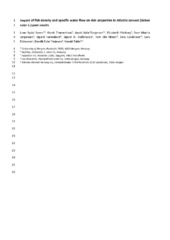| dc.contributor.author | Sveen, Lene Rydal | |
| dc.contributor.author | Timmerhaus, Gerrit | |
| dc.contributor.author | Torgersen, Jacob Seilø | |
| dc.contributor.author | Ytteborg, Elisabeth | |
| dc.contributor.author | Jørgensen, Sven Martin | |
| dc.contributor.author | Handeland, Sigurd Olav | |
| dc.contributor.author | Stefansson, Sigurd Olav | |
| dc.contributor.author | Nilsen, Tom Ole | |
| dc.contributor.author | Calabrese, Sara | |
| dc.contributor.author | Ebbesson, Lars O.E. | |
| dc.contributor.author | Terjesen, Bendik Fyhn | |
| dc.contributor.author | Takle, Harald Rune | |
| dc.date.accessioned | 2018-02-08T12:48:38Z | |
| dc.date.available | 2018-02-08T12:48:38Z | |
| dc.date.issued | 2016 | |
| dc.Published | Sveen L, Timmerhaus GF, Torgersen J, Ytteborg E, Jørgensen SM, Handeland SO, Stefansson SO, Nilsen TO, Calabrese, Ebbesson L, Terjesen Bf, Takle HR. Impact of fish density and specific water flow on skin properties in Atlantic salmon (Salmo salar L.) post-smolts. Aquaculture. 2016;464:629-637 | eng |
| dc.identifier.issn | 1873-5622 | en_US |
| dc.identifier.issn | 0044-8486 | en_US |
| dc.identifier.uri | https://hdl.handle.net/1956/17352 | |
| dc.description.abstract | Prolonged production of Atlantic salmon (Salmo salar) post-smolts in closed-containment systems has prompted research into biological requirements under higher production intensities. This study examined the effect of fish density and specific water flow on skin health in post post-smolts particularly focusing on epithelial cell morphology and gene expression. In the density experiment, post-smolts were kept at five different fish densities (25, 50, 75, 100 and 125 kg/m3) at a specific water flow rate of 0.6 l/kg/min. Microscopic examination of fluorescence stained whole-mount skin samples demonstrated differences in epithelial cell morphology with increased spacing between epithelial cells at 50 kg/m3 and 125 kg/m3. Gene expression analysis revealed increased transcription of mucin-like 2, cathepsins B, -D, -L, matrix metalloproteinase 9 and claudin 10 in fish reared at a density of 125 kg/m3, while only matrix metalloproteinase 9 and claudin 10 had increased transcription at a density of 100 kg/m3. Together, these results suggest structural alterations in the skin epithelium at densities ≥ 100 kg/m3. In the specific water flow experiment, four different water flow levels were established (0.2, 0.3, 0.4 and 0.5 l/kg/min) while the fish density was kept constant at 75 kg/m3. After eight weeks, transcription of mucin-like 2 and -5ac, inducible nitric oxide synthase, lysozyme and cathepsin B and -L increased in skin samples from fish reared in tanks with a specific water flow of ≤ 0.3 l/kg/min. Increased transcription of these genes implies activation of stress and immune responses in skin at low specific water flow. Results from this study suggests that skin is a sensitive organ for environmental changes, and suggests several molecular indicators that may be valuable in predicting the effects of varying rearing conditions on skin health. Further validation through long-term studies, combined with other health parameters is required for practical recommendations regarding critical fish density and water flow for optimal fish health and performance in semi-closed production systems. | en_US |
| dc.language.iso | eng | eng |
| dc.publisher | Elsevier | en_US |
| dc.rights | Attribution CC BY-NC-ND | eng |
| dc.rights.uri | http://creativecommons.org/licenses/by-nc-nd/4.0/ | eng |
| dc.subject | Closed-containment systems | eng |
| dc.subject | Skin health | eng |
| dc.subject | Fish density | eng |
| dc.subject | Specific water flow | eng |
| dc.subject | Fish welfare | eng |
| dc.title | Impact of fish density and specific water flow on skin properties in Atlantic salmon (Salmo salar L.) post-smolts | en_US |
| dc.type | Peer reviewed | |
| dc.type | Journal article | |
| dc.date.updated | 2017-09-29T13:04:52Z | |
| dc.description.version | acceptedVersion | en_US |
| dc.rights.holder | Copyright 2016 Elsevier | en_US |
| dc.identifier.doi | https://doi.org/10.1016/j.aquaculture.2016.08.012 | |
| dc.identifier.cristin | 1389265 | |
| dc.source.journal | Aquaculture | |
| dc.relation.project | Norges forskningsråd: 217502 | |
| dc.relation.project | Norges forskningsråd: 233870 | |
| dc.relation.project | Fiskeri- og havbruksnæringens forskningsfond: 900816 | |

